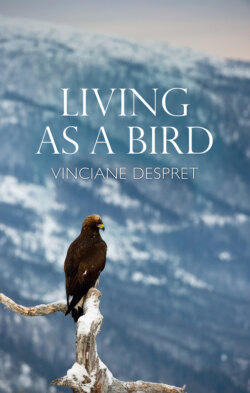Читать книгу Living as a Bird - Vinciane Despret - Страница 10
Notes
Оглавление1 1. This is, for example, the hypothesis developed by Ernst Mayr, ‘Bernard Altum and the territory theory’, Proceedings of the Linnaean Society, 45–6 (1935): 24–30.
2 2. I am referring here to Margaret Morse Nice, ‘The role of territory in bird life’, American Midland Naturalist, 26/3 (1941): 441–87, and to David Lack, ‘Early reference to territory in bird life’, Condor, 46 (1944): 108–11.
3 3. T. Birkhead and S. Van Balen, ‘Bird-keeping and the developments of ornithological science’, Archives of Natural History, 35/2 (2008): 281–305, at p. 286. I would add, since we are on the subject of appropriation, that the work of these two writers involves highlighting this form of amnesia, very prevalent among scientific ornithologists when it comes to the knowledge of bird amateurs, knowledge they nevertheless make extensive use of, though without acknowledgement.
4 4. P. Descola, ‘Les Usages de la terre: cosmopolitique de la territorialité’ [The uses of land: cosmopolitics of territoriality], lecture (in French) given at the Collège de France, 2 March 2016. On the same subject, see also S. Vanuxem, La Propriété de la terre. Marseilles: Wildproject, 2018.
5 5. For the jurist Grotius (1583–1645), and as Philippe Descola reminds us, individual and collective appropriation was only possible because of the existence of a basic right during the fictional pre-social period, which he refers to as a ‘state of nature’. This ‘natural’ right ensured that each human being had free access to everything: ‘Each man could at once take whatever he wished for his own needs, and could consume whatever was capable of being consumed …. Whatever each had thus taken for his own use another could not take from him except by an unjust act.’
6 6. On this subject, see in particular Sarah Vanuxem, who examines the resources of legal history to find ways of modifying the modern conception of ownership. See also, with a view to providing food for thought and envisaging the possibility of a reappropriation of the ‘commons’, the very fine article written by S. Gutwirth and I. Stengers, ‘Le Droit à l’épreuve de la résurgence des commons’, Revue juridique de l’environnement, 41/2 (2016): 306–43.
7 7. Cited ibid., p. 312.
8 8. E. Blaze, ‘Moeurs et usages de la vie privée: chasse, vénerie, fauconnerie, oisellerie’, in P. Lacroix and F. Seré (eds), Le Moyen Âge et la Renaissance: histoire et description des moeurs et usages, du commerce et de l’industrie, des sciences, des arts, des littératures et des beaux-arts en Europe, vol. 1. Paris: Editions Paris Administration, 1848, pp. i–xix. It should be noted that the author points out that, even in the fifteenth century, bird keeping was a profession subject to rules and regulations and bringing with it certain privileges (in particular, that of being able to hang up bird cages in Paris shops without the permission of tenants, and also the right accorded to master bird-catchers to hunt and sell birds).
9 9. H. E. Howard, Territory in Bird Life. London: Collins, [1920] 1948, p. 16.
10 10. K. Lorenz, On Aggression. London: Routledge, 2002, p. 32.
11 11. I shall deliberately maintain silence, in the text itself, on the subject of Robert Ardrey’s book The Territorial Imperative, which looks for the instinctive origins of property and nations (no less) within the animal kingdom. Under the pretext of an invitation to humility (let us accept our animal origins and our instincts, and all will be well), the reader finds himself confronted with the return of the most conservative and patriarchal natural law of our social organizations. In order not to waste time, we will simply draw attention to the criticism made by Engels, at the end of the nineteenth century, of social Darwinists, when he denounced what he called ‘a conjuring trick’: we transpose our concepts, our uses and our categories of society onto nature, then we reapply them to society, and these categories, organizations and uses become natural laws.
12 12. Nice, ‘The role of territory in bird life’, p. 470.
13 13. I. Stengers, Civiliser la modernité? Whitehead et les ruminations du sens commun. Dijon: Les Presses du réel, ‘Drama’ collection, 2017, pp. 135–8.
14 14. M. Serres, Malfeasance: Appropriation through Pollution?. Stanford, CA: Stanford University Press, 2011.
15 15. M. Serres, The Natural Contract. Ann Arbor: University of Michigan Press, 1995, p. 39.
16 16. M. Serres, Darwin, Bonaparte et le Samaritain: une philosophie de l’histoire. Paris: Le Pommier, 2016, p. 16, and onwards for all other quotations in this section.
17 17. Serres, Malfeasance, p. 1.
18 18. Ibid., p. 3.
19 19. Ibid., p. 8.
20 20. Ibid., p. 12.
21 21. Ibid., p. 3.
22 22. For the exact reference see ibid., p. 41.
23 23. J.-C. Bailly, The Animal Side. New York: Fordham University Press, 2011.
24 24. L. Giuggioli, J. R. Potts, D. I. Rubenstein and S. A. Levin, ‘Stigmergy, collective actions, and animal social spacing’, Proceedings of the National Academy of Sciences, 42 (2013): 16904–9.
25 25. V. Geist, ‘On the rutting behavior of the mountain goat’, Journal of Mammology, 45/4 (1965): 562; H. Hediger, Wild Animals in Captivity. London: Butterworths, 1950.
26 26. R. A. Hinde, ‘The biological significance of the territories of birds’, Ibis, 98 (1956): 340–69, at p. 342.
27 27. My thanks to Baptiste Morizot, my generous and attentive reader, for drawing my attention to this.
